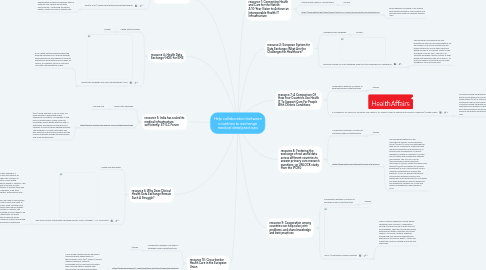
1. resource 3: What is HIE?
1.1. Health Information Exchange
1.1.1. Google
1.2. What is HIE? | HealthIT.govtwitterrss2youtube2linkedin
1.2.1. Electronic health information exchange (HIE) allows doctors, nurses, pharmacists, other health care providers and patients to appropriately access and securely share a patient’s vital medical information electronically—improving the speed, quality, safety and cost of patient care.
2. resource 4: Health Data Exchange (HDE) for EMS
2.1. Health Data Exchange
2.1.1. Google
2.2. Health Data Exchange and Data Interoperability | ESO
2.2.1. ESO Health Data Exchange bridges the data gap between EMS and the hospital, with bidirectional data sharing to support operational and quality process needs. All secure, all auditable, and all in real time. True data interoperability is here.
3. resource 5: India has scaled its medical infrastructure sufficiently: ET-ILC Forum
3.1. Medial Data Exchange
3.1.1. Learning Hub
3.2. https://global-factiva-com.ezp.em-lyon.com/ga/default.aspx
3.2.1. (BSV) along with the IT arm of India, NIC have worked on expanding India’s healthcare ecosystem considerably in the last six months which is why India has among the lowest death rates per lakh of population worldwide and now has built capacity to care for those getting infected. The lockdown is a blunt instrument and was effective in giving the country and the medical fraternity enough time to prepare and scale infrastructure.
4. resource 6: Why Does Clinical Health Data Exchange Remain Such A Struggle?
4.1. Health Data Exchange
4.2. Why Does Clinical Health Data Exchange Remain Such A Struggle? - HIT Consultant
4.2.1. Until electronic data sharing is a requirement for the vast majority of clinicians, providers will continue to postpone adoption. Some health systems—as well as health IT vendors—will continue to stand in the way of data sharing in an attempt to protect their own self-interests. Ultimately, if we want widespread adoption, data sharing must be mandated. At the same time, we need to improve the technology so that it offers real value to providers. Clinicians using certified EHRs have the capabilities they require already built into their systems. However, the format for transmitted records needs to be streamlined so physicians can easily identify the patient’s relevant issues. Extraneous information must be eliminated so that the care process is optimized.
5. resource 10: Cross-border Health Care in the European Union
5.1. collaboration between countries to exchange medical data/practices
5.1.1. Google
5.2. https://www.euro.who.int/__data/assets/pdf_file/0004/135994/e94875.pdf
5.2.1. Cross-border health care has become a more prominent phenomenon in the European Union (EU). When in need of medical treatment, patients increasingly act as informed consumers who claim the right to choose their own provider, including beyond their national borders. They are supported and encouraged in this by several factors and actors, including the Internet, internationally trained health professionals, and so on.
6. resource 2: European System for Data Exchange: What Are the Challenges for Healthcare?
6.1. Healthcare Data Exchange
6.1.1. Google
6.2. European System for Data Exchange: What Are the Challenges for Healthcare?
6.2.1. The European Commission has just presented a series of recommendations for the creation of a secure system that will enable citizens to access their electronic health records in all Member States of the European Union by 2021. The aim is to facilitate European citizens' access to their health data wherever they are in the EU, to improve medical monitoring and to make emergency care more efficient.
7. resource 7: A Comparison Of How Four Countries Use Health IT To Support Care For People With Chronic Conditions
7.1. collaboration between countries to exchange medical data/practices
7.1.1. Google
7.2. A Comparison Of How Four Countries Use Health IT To Support Care For People With Chronic Conditions | Health Affairs
7.2.1. Countries around the globe are investing in health information and communications technologies (ICTs) as critical tools for improving care for chronically ill patients. Countries around the globe are making substantial investments in health information and communications technologies (ICTs) to improve the quality and efficiency of health care.
8. resource 8: Fostering the exchange of real world data across different countries to answer primary care research questions: an UNLOCK study from the IPCRG
8.1. collaboration between countries to exchange medical data/practices
8.1.1. Google
8.2. https://www.nature.com/articles/s41533-018-0075-9
8.2.1. The founding ambitions of the International Primary Care Respiratory Group (IPCRG) in 2000 included sharing data across countries to understand the real world similarities and differences in primary care management of chronic respiratory disease in different countries and to create large longitudinal datasets more rapidly. The UNLOCK Group (uncovering and noting long-term outcomes in chronic obstructive pulmonary disease (COPD) and asthma to enhance knowledge) is one of the projects IPCRG members established to achieve this ambition. It is an on-going international collaboration between primary care researchers and practitioners to coordinate and share datasets of relevant diagnostic and prognostic variables for COPD and asthma management, which began in 2010.
9. resource 9: Cooperation among countries can help solve joint problems, and share knowledge and best practices
9.1. collaboration between countries to exchange medical data/practices
9.1.1. Google
9.2. WHO | Cooperation among countries
9.2.1. Many countries experience similar health challenges and concerns. Cooperation among countries can be an effective tool to strengthen, share and accelerate health development within countries and across regions. It involves creating, adapting, transferring and sharing knowledge and experiences to improve health – while also making the most of existing resources and capacities.
10. resource 1: Connecting Health and Care for the Nation: A 10-Year Vision to Achieve an Interoperable Health IT Infrastructure
10.1. Interoperable Health IT Infrastructure
10.1.1. Google
10.2. https://www.healthit.gov/sites/default/files/ONC10yearInteroperabilityConceptPaper.pdf
10.2.1. Broad adoption of health IT will require that health information can be easily and appropriately shared to support multiple uses.
